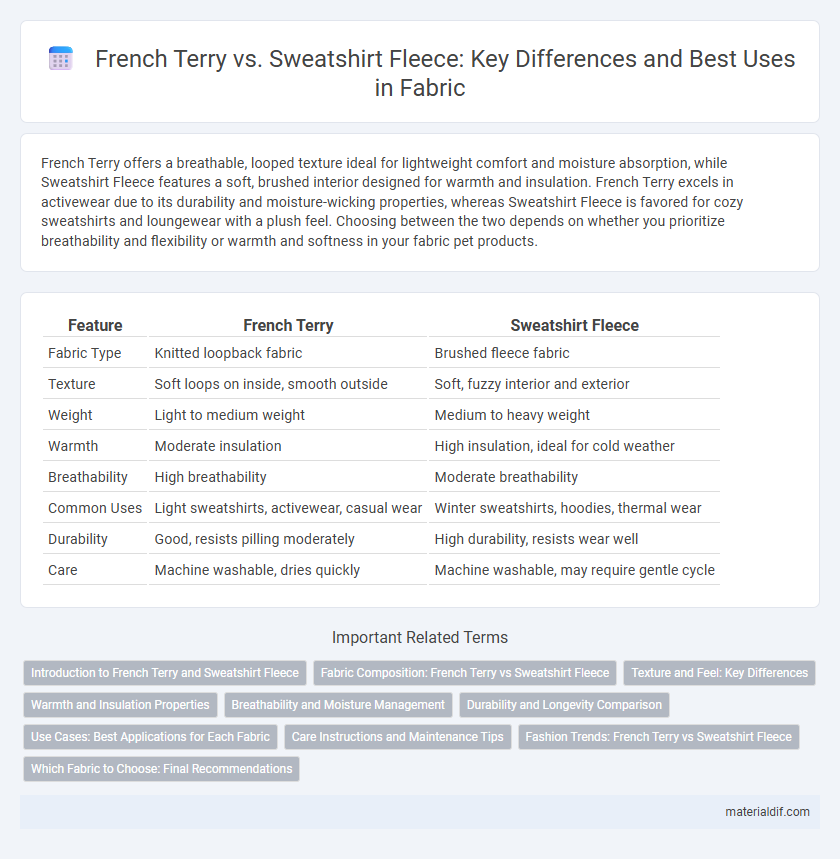French Terry offers a breathable, looped texture ideal for lightweight comfort and moisture absorption, while Sweatshirt Fleece features a soft, brushed interior designed for warmth and insulation. French Terry excels in activewear due to its durability and moisture-wicking properties, whereas Sweatshirt Fleece is favored for cozy sweatshirts and loungewear with a plush feel. Choosing between the two depends on whether you prioritize breathability and flexibility or warmth and softness in your fabric pet products.
Table of Comparison
| Feature | French Terry | Sweatshirt Fleece |
|---|---|---|
| Fabric Type | Knitted loopback fabric | Brushed fleece fabric |
| Texture | Soft loops on inside, smooth outside | Soft, fuzzy interior and exterior |
| Weight | Light to medium weight | Medium to heavy weight |
| Warmth | Moderate insulation | High insulation, ideal for cold weather |
| Breathability | High breathability | Moderate breathability |
| Common Uses | Light sweatshirts, activewear, casual wear | Winter sweatshirts, hoodies, thermal wear |
| Durability | Good, resists pilling moderately | High durability, resists wear well |
| Care | Machine washable, dries quickly | Machine washable, may require gentle cycle |
Introduction to French Terry and Sweatshirt Fleece
French Terry is a knit fabric known for its soft, looped texture on one side and smooth surface on the other, making it lightweight and breathable. Sweatshirt Fleece features a plush, fuzzy interior that provides superior warmth and insulation, commonly used in cold-weather apparel. Both fabrics are popular in casual wear but differ significantly in texture, weight, and thermal properties.
Fabric Composition: French Terry vs Sweatshirt Fleece
French Terry fabric is typically composed of 100% cotton or a cotton-polyester blend, featuring loops on the inside and a smooth surface on the outside, which provides breathability and moisture-wicking properties. Sweatshirt Fleece usually consists of a heavier cotton-polyester blend with a soft, brushed interior fleece that offers enhanced warmth and insulation. The distinct fabric composition differences between French Terry and Sweatshirt Fleece influence their suitability for varying climatic conditions and active or casual wear.
Texture and Feel: Key Differences
French Terry features a smooth, soft surface with characteristic looped textures on the inside, offering a lightweight yet cozy feel ideal for moderate warmth. Sweatshirt fleece has a more plush, dense nap lining, providing extra insulation and a fuzzier, warmer touch suited for colder conditions. The key difference lies in French Terry's breathable looped fabric compared to the thick, velvety fleece texture that enhances heat retention.
Warmth and Insulation Properties
French Terry fabric features a looped back that provides moderate warmth and breathability, making it suitable for mild to cool weather. Sweatshirt fleece consists of a brushed fleece interior that offers superior insulation and heat retention, ideal for colder conditions. The denser knit and softer texture of sweatshirt fleece enhance its ability to trap body heat compared to the lighter, more airy structure of French Terry.
Breathability and Moisture Management
French Terry fabric offers superior breathability with its looped back knit structure, allowing better air circulation and moisture wicking compared to Sweatshirt Fleece. Sweatshirt Fleece, characterized by its dense, brushed interior, provides enhanced insulation but tends to trap moisture, reducing breathability and drying time. Choosing between these fabrics depends on activity level; French Terry excels in moisture management for active wear, while Sweatshirt Fleece is suited for warmth in cooler, low-activity conditions.
Durability and Longevity Comparison
French Terry fabric offers superior durability due to its looped back construction, which provides enhanced resistance to pilling and wear compared to sweatshirt fleece. Sweatshirt fleece, with its soft, brushed interior, tends to show signs of wear more quickly, especially in high-friction areas. Over time, French Terry maintains its structural integrity and appearance longer, making it a preferred choice for garments requiring extended longevity.
Use Cases: Best Applications for Each Fabric
French Terry fabric is ideal for lightweight activewear, casual wear, and transitional season clothing due to its moisture-wicking and breathable properties. Sweatshirt fleece is better suited for colder weather garments like hoodies, sweatpants, and outerwear, providing superior warmth and insulation. Both fabrics excel in comfort but cater to different temperature needs and activity levels.
Care Instructions and Maintenance Tips
French Terry fabric requires gentle washing in cold water and air drying to maintain its soft loops and durability, avoiding bleach or fabric softeners that can degrade fibers. Sweatshirt Fleece benefits from a similar cold wash but should be tumble dried on low heat to preserve its plush interior and prevent pilling. Both fabrics respond well to turning garments inside out before washing to minimize abrasion and extend fabric life.
Fashion Trends: French Terry vs Sweatshirt Fleece
French Terry fabrics have surged in popularity within sustainable fashion trends due to their moisture-wicking properties and lightweight nature, making them ideal for athleisure and casual wear. Sweatshirt fleece remains a staple in cozy, winter apparel with its plush interior and superior warmth retention, favored in streetwear and oversized silhouettes. Designers increasingly blend French Terry and sweatshirt fleece in hybrid garments, combining functionality with contemporary style for versatile, year-round use.
Which Fabric to Choose: Final Recommendations
French Terry offers a lightweight, breathable texture ideal for activewear and mild weather, while Sweatshirt Fleece provides a thicker, warmer feel suited for colder climates and cozy apparel. Choose French Terry for moisture-wicking performance and a casual look, whereas Sweatshirt Fleece excels in insulation and softness for maximum comfort. Consider your specific needs in temperature regulation and fabric weight when selecting between these two versatile textile options.
French Terry vs Sweatshirt Fleece Infographic

 materialdif.com
materialdif.com